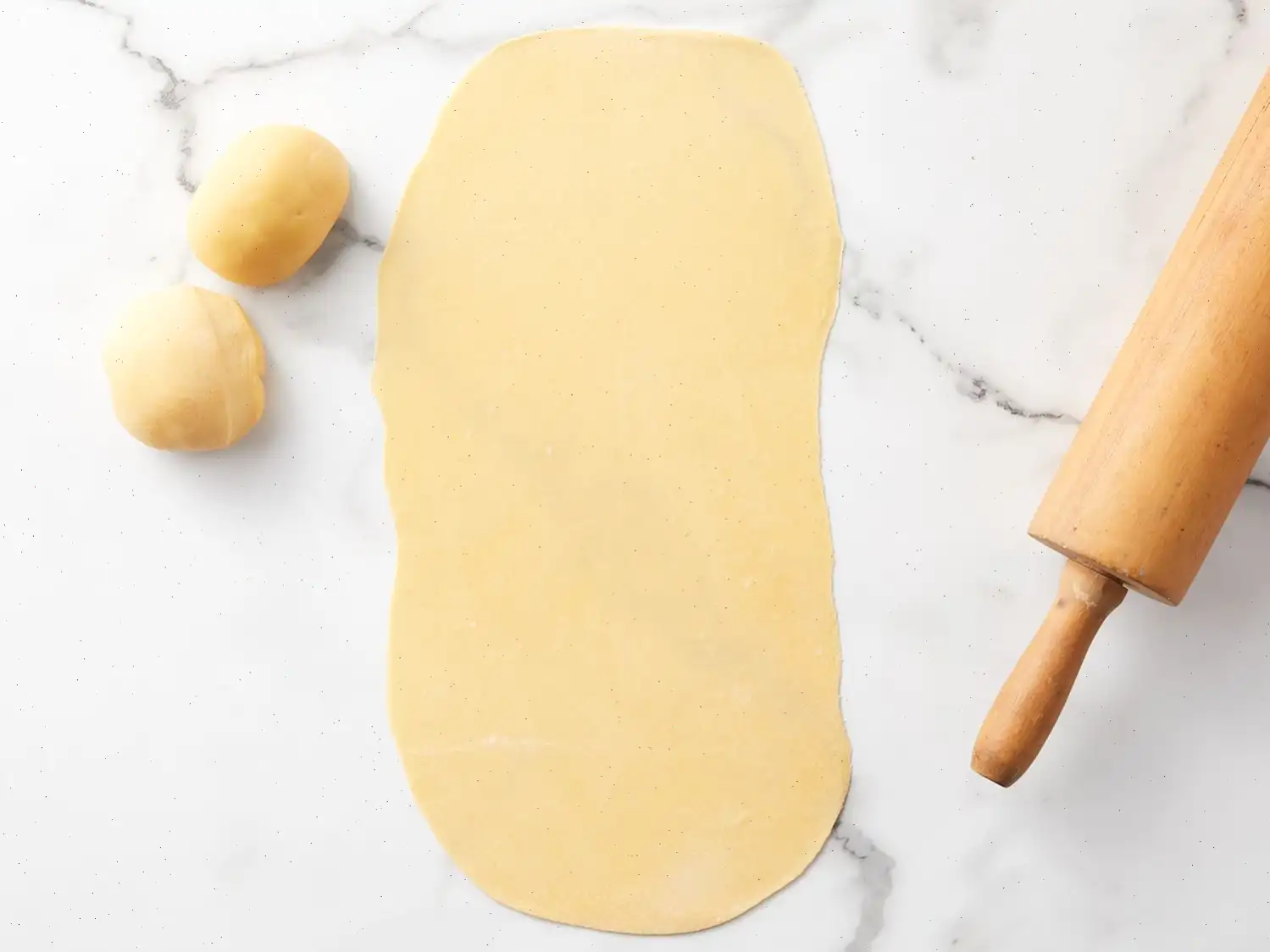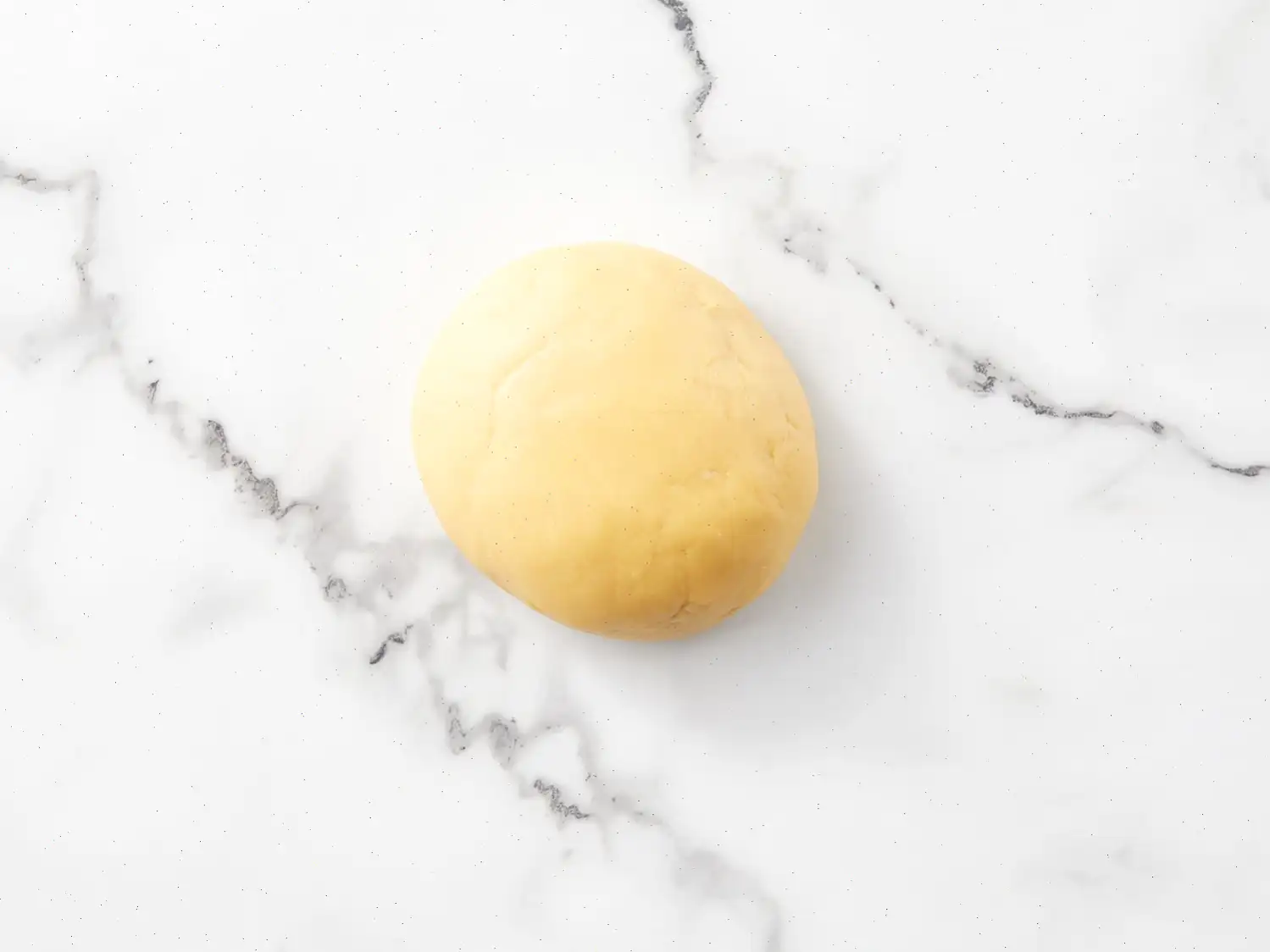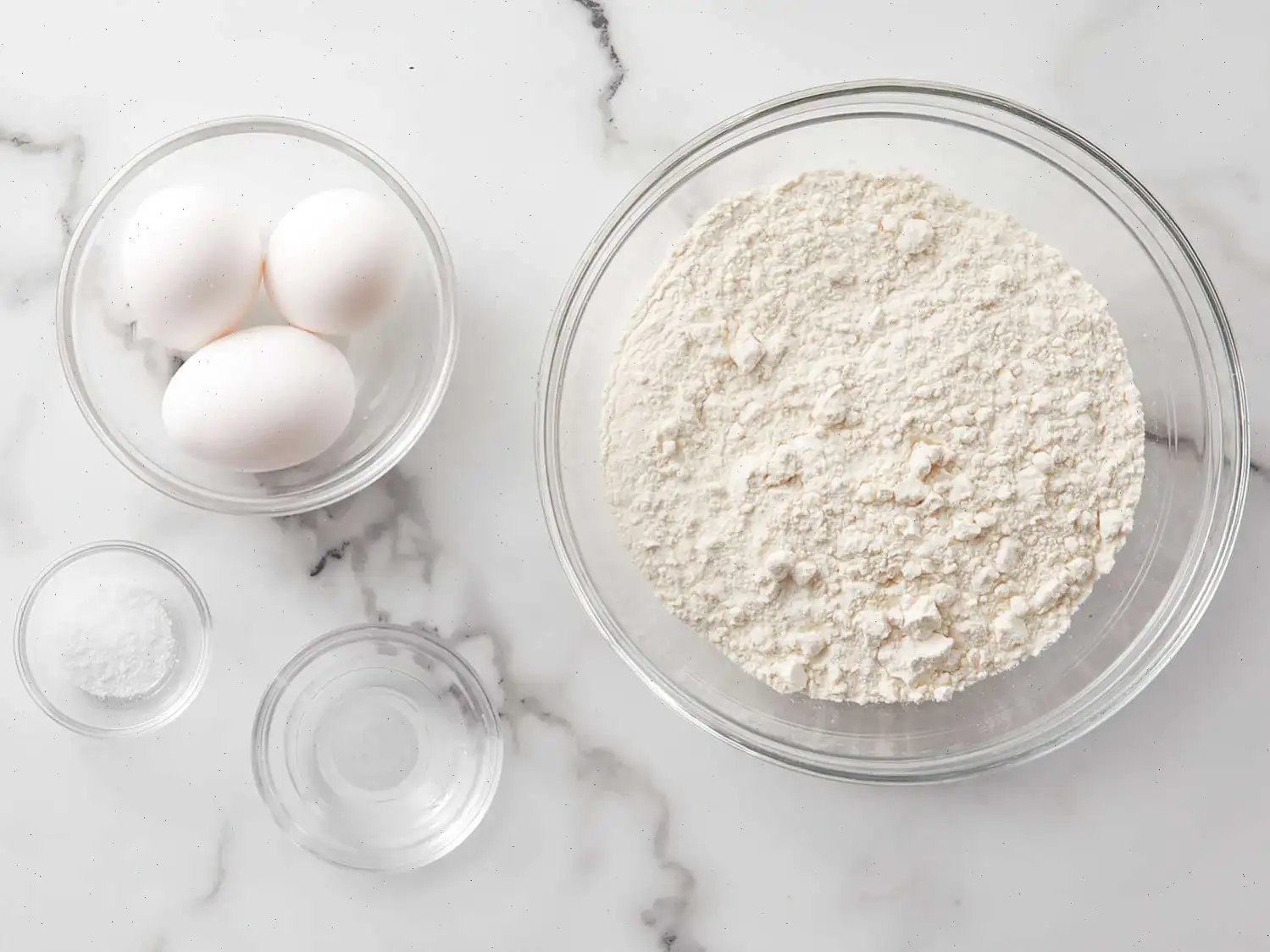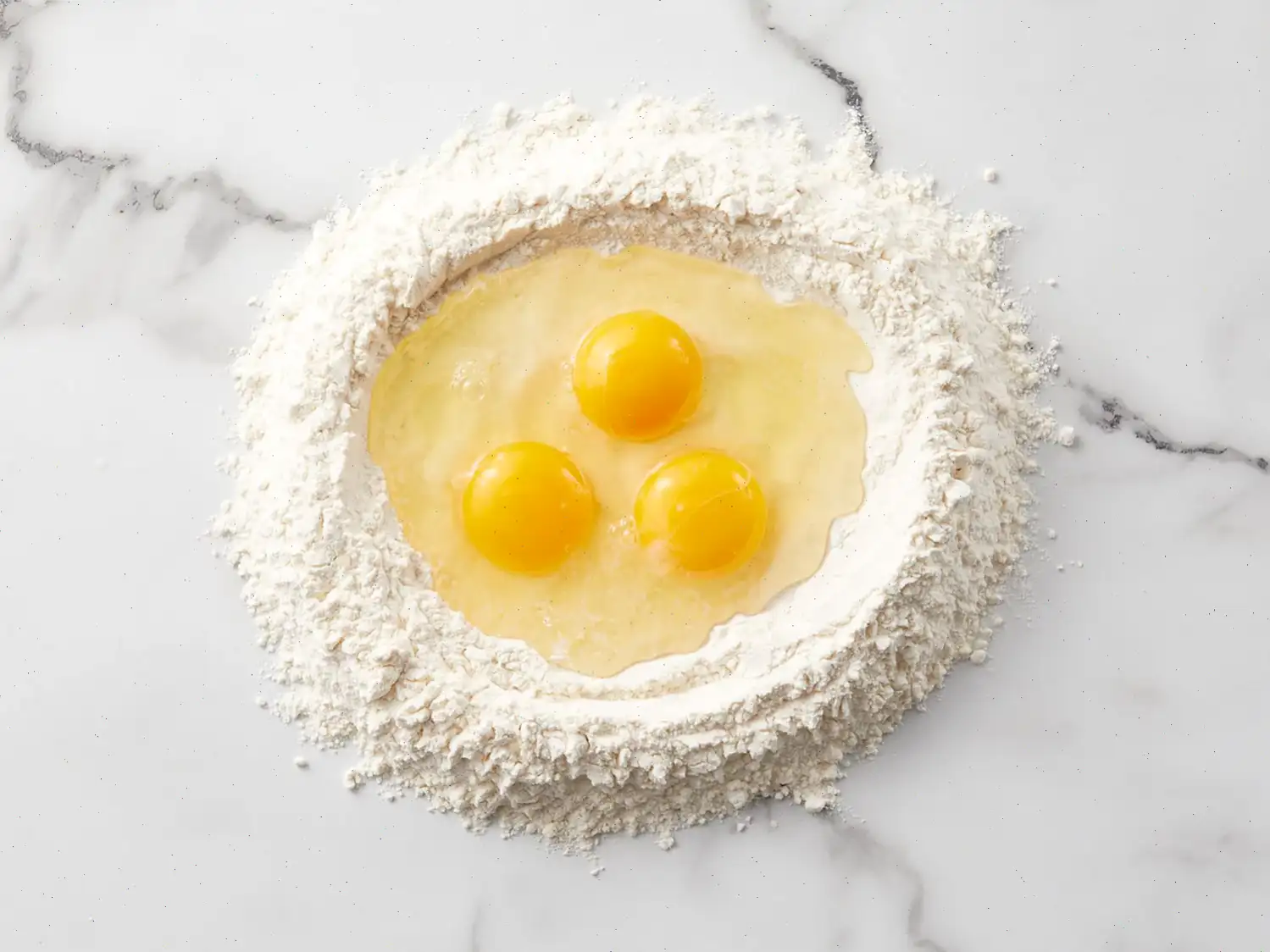
Homemade Lasagna Sheets Recipe
Homemade Lasagna Sheets
Servings: 4
Prep time: 1 hour
Cook time: Varies (depending on lasagna assembly)
Ingredients
- 2 cups Italian-style tipo 00 flour, plus extra for dusting
- 3 large eggs
- 1 pinch salt
- 1 tablespoon water (as needed)
Directions
Step 1: Gather all ingredients and set up your workspace with a clean marble or wooden surface.
Step 2: Pile the flour onto the work surface and make a well in the center. Crack the eggs into the well and add the pinch of salt.
Step 3: Gently beat the eggs with a fork, incorporating the surrounding flour gradually, until the mixture starts to become runny.
Step 4: Use a bench scraper to bring the remaining flour into the egg mixture until a dough forms. If the dough is too stiff, add water one tablespoon at a time until the dough reaches a smoother consistency.
Step 5: Begin kneading the dough with your hands. Flatten it, stretch it, and fold the top part towards the center. Turn the dough 45 degrees and repeat. Continue this process for about 10 minutes, until the dough is soft and smooth.
Step 6: Shape the dough into a ball. Cover it with plastic wrap and refrigerate for 30 minutes to 1 hour until it firms up.
Step 7: After resting, divide the dough into 3 equal portions. Take one portion and flatten it slightly with your hands.
Step 8: Dust your work surface with flour, then use a rolling pin to roll the dough out. Roll it 5 to 6 times, turning the dough 45 degrees each time and rolling until the dough is paper-thin. You should be able to see your fingers through it when held up.
Step 9: Cut the thin dough into rectangular sheets, making sure they fit your baking dish. Use a pastry wheel or a sharp knife for cutting.
Step 10: Lay the pasta sheets on a floured kitchen towel and allow them to air-dry for about 30 minutes before assembling your lasagna.
Recipe Tips
If you wish to prepare the pasta ahead of time, let the sheets air-dry overnight. Be sure to dust them with additional flour if they feel too wet. Once fully dry, store the pasta in a paper bag and use within a couple of days.
Alternative: Pasta Machine Method
Step 1: Divide the dough into 3 equal portions. Flatten one portion and pass it through the thickest setting of the pasta machine. Dust lightly with flour, fold it in half like a book, and pass through 3 to 4 times, always flouring and folding between passes.
Step 2: Once the dough is smooth, switch the machine to a middle setting and pass the dough through again. Then set to the next-to-last setting and pass the dough through again.
Step 3: For the final pass, use the thinnest setting on the machine. Cut the dough into long sheets and place them on a floured cloth. Repeat with the remaining dough portions.
Step 4: Allow the sheets to air-dry for about 30 minutes, trim to fit your baking dish, and then proceed with your lasagna assembly and baking.
Nutrition Facts (per serving)
- Calories: 297
- Total Fat: 5g (6% DV)
- Saturated Fat: 1g (7% DV)
- Cholesterol: 140mg (47% DV)
- Sodium: 93mg (4% DV)
- Total Carbohydrate: 49g (18% DV)
- Dietary Fiber: 2g (6% DV)
- Protein: 13g (26% DV)
- Calcium: 30mg (2% DV)
- Iron: 4mg (21% DV)
- Potassium: 118mg (3% DV)
* Percent Daily Values are based on a 2,000 calorie diet. Your daily values may be higher or lower depending on your calorie needs.
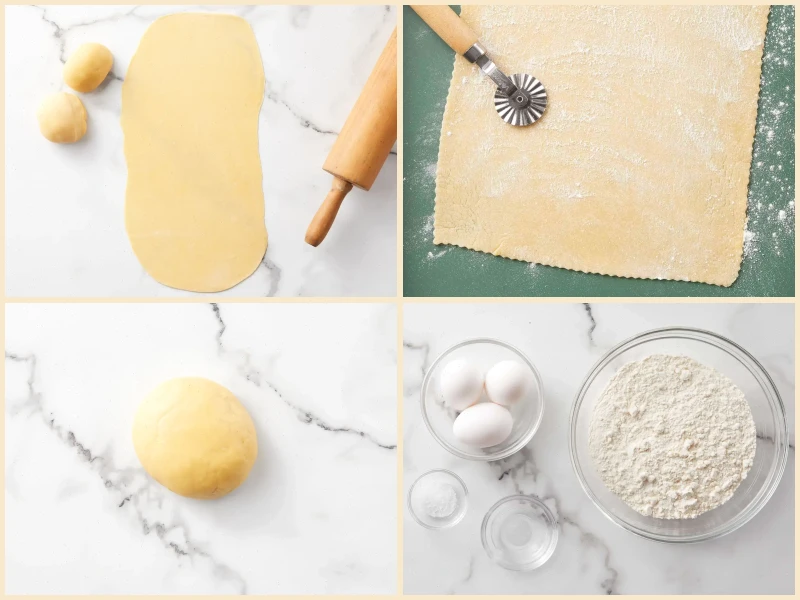

Origin and History
Lasagna, a dish that has become synonymous with Italian cuisine, has a rich history that dates back centuries. While the concept of layering pasta with sauce and cheese is ancient, the specific technique of creating lasagna sheets from scratch has evolved over time. The earliest mention of lasagna can be traced to Ancient Greece, where a dish called "Laganon" was prepared by layering pasta with various ingredients. However, the lasagna we know todaythin, delicate pasta sheets interspersed with rich meats, cheeses, and saucewas perfected in Italy, particularly in the Emilia-Romagna region, home to Bologna. There, the pasta sheets became an essential part of the world-famous Lasagna alla Bolognese.
Regional Variations
In Italy, lasagna varies from region to region. The most famous version, "Lasagna alla Bolognese," hails from Bologna in northern Italy and includes a meat sauce (rag) and bchamel sauce. In contrast, southern Italy prefers a more straightforward version, often using tomato-based sauces, mozzarella, and ricotta. The sheets themselves can differ, with northern versions typically using egg-based dough, while southern versions may use water and flour for a more rustic texture. Homemade lasagna sheets, made from the finest "00" flour and eggs, are a hallmark of authentic Italian cooking, offering a texture and flavor that store-bought alternatives can rarely match.
Difference from Similar Dishes
Although many pasta dishes feature layered pasta, lasagna stands out due to its unique combination of wide, flat sheets and rich fillings. Unlike other pasta types, such as ravioli or fettuccine, lasagna sheets are large enough to cover the entire baking dish, providing a sturdy foundation for the layers of sauce, cheese, and meat. What sets homemade lasagna sheets apart from pre-made varieties is the freshness and texture they impart, allowing for a more cohesive dish with a perfect balance between pasta and fillings.
Where is Lasagna Traditionally Served?
Lasagna is a beloved dish served throughout Italy, often at family gatherings, festive occasions, or Sunday meals. Its hearty and satisfying nature makes it an ideal choice for celebrations, especially around holidays like Christmas or Easter. Outside of Italy, lasagna has become a staple in Italian-American cuisine, where its often seen as a comforting dish to serve at large gatherings, including holiday dinners and casual family meals. Whether at an Italian trattoria or in the comfort of one's home, lasagna remains a symbol of hospitality and tradition.
Interesting Facts
Did you know that the world record for the largest lasagna was set in 2012 in Rome? This colossal dish weighed a whopping 51,257 pounds and required a team of chefs to prepare it! Additionally, while lasagna is often thought of as a dish from northern Italy, the oldest recorded lasagna recipes actually come from the southern regions. In ancient times, Lasagna was typically prepared without tomato sauce, as tomatoes were not introduced to Europe until after the Columbian Exchange.
You can listen to this recipe in AI audio format. Simply click the play button below to listen to the content in a format that suits you best. It’s a great way to absorb information on the go!
FAQ about Homemade Lasagna Sheets Recipe
Comments
kksw
10/06/2025 01:52:54 PM
Easy as can be! I added 1T. olive oil the second time I made this and the results were better (I thought). I don’t have a pasta machine but my marble rolling pin worked just as well. I was out of lasagna noodles but never will be again!
FlashyTofu9329
05/05/2024 11:22:07 AM
Really easy to do...
Michael Perez
03/03/2024 01:53:33 AM
Made it for lunch — gone too fast.
PerkyFlour4537
09/07/2023 05:52:57 AM
The absolute Best pasta. Made the dough the night before, added tablespoon oil and completed it in the morning.
Ashlynn
04/12/2021 12:06:16 AM
This took me five hours but like it’s good
Not A Chef
04/01/2021 04:42:34 AM
I had never made pasta before this recipe. Somewhat time consuming for the first sheet, but i soon got the hang of it. The taste is very good and fresh. I has
Shawnee
03/18/2021 11:18:40 PM
It came out perfect! Thank you!


